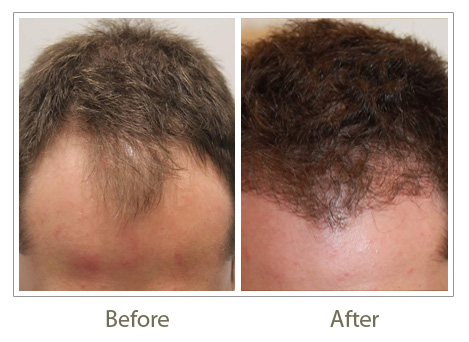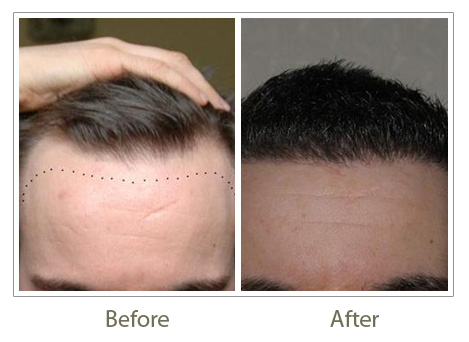Hair Growth post transplantation by FUE
Follicular Unit Extraction - The No Scalpel, No Strip, Minimally Invasive Procedure
Follicular Unit extraction or FUE is a relatively new technique of extracting grafts individually from the scalp. In this type of procedure a small round punch generally less than 1.00 mm in diameter is used to make a small circular incision around the follicular unit. These follicular units are then individually plucked from the scalp. This new procedure negates the need for a linear incision at the back and sides of the scalp with the inevitable scar that is produced.
The extracted follicles are then transplanted into the client's bald or thinning patch on the scalp, or in the pre-planned eyebrow area. FUE is carried out under local anesthesia ensuring full client awareness of what is going on throughout the procedure. Each follicle extracted from the client’s donor area and transplanted into the treated area is perfectly placed to match the hair arrangement, orientation, growth, angle and direction of the rest of the natural hair. All this is done with the utmost care and to the highest degree of client comfort.

Hair Regrowth post transplantation by FUE
The newly transplanted hair into the scalp is immediately visible, however, the hair cycle may involve the falling out of some of the transplanted hairs which then regrow after about 16 weeks. The newly transferred hair grows naturally in its new location for the rest of the person's life. Transferred hair is completely healthy and natural in appearance. Even persons with substantially receding hairlines and bald areas can receive very good coverage with FUE.
Benefits of FUE
- Permanently Restores Natural Hair Growth
- For Both Men & Women
- No Scarring
- No Bleeding
- No Incision
- Minimal to Nil Discomfort
Best Candidates for Follicular Unit Extraction
The best candidates for FUE hair transplant procedure include:
- Patients interested in a smaller size procedure (typically up to 1,000 grafts).
- Patients with a limited donor supply.
- Patients with limited scalp elasticity.
- Patient who have had several FUT procedures and subsequently have a limited donor supply or limited scalp elasticity.
- Patients who have a need or desire to wear their hair exceptionally short.
- Patients who don't mind closely clipping the donor area hair at the time of the procedure.
The Strip Technique
FUT (Follicular Unit Transplantation) Strip Harvesting - a strip of scalp is removed under local anesthesia, the wound is then sutured back together and this piece of scalp tissue is then cut in to small pieces of tissue called grafts. This method will leave a linear scar in the donor area, which should be covered by a patient's hair (if long). The recovery period is around 2 weeks and will require the stitches to be removed by medical personnel.
Under the microscope follicular units are identified and dissected in a way that leaves them intact in their genetic form. They are then placed in the recipient area with the appropriate density, distribution, direction, angulations and orientation thus giving natural results.
| Strip Hair Transplant | FUE Hair Transplant | |
|---|---|---|
| Stitch | Cutting open the skin and closing it with stitches, so can have stitch related problems | No stitches. Minimally invasive |
| Scar | Stitches leave permanent scar at the back of the head. You cannot keep your hair short because the scar will be visible | Multiple pin head tiny marks which are not visible even if you keep you trim your hair to the size "0" |
| Stretching of Scar | Can prolong healing period and one has to avoid physical activity for weeks | No such problem and one can start physical activity soon after transplant |
| Recovery | 2-3 weeks usually need 1 month of rest for atheletes, body builders etc | 3-4 days. Exercise, weight training, sports, can be resumed in 4-5 days |
| Donor Complications | Not uncommon e.g. wide scar, painful scar, delayed healing of stitches and give away of stitches | Practically nil |
| Short hair style | Scar becomes visible, so sporting long hair style is mandatory | Can easily sport short hair style |
| Numbness above stitches | Numbness above the stitches often last for months or permanently due to division of nerves in the line of cut | No numbness because there is no division of nerves |
| Pain in the stitches | Pain for 10-30 days and sometimes even permanently due to entrapment of nerve in the area of cut | Practically no post-operative pain |
| Tightness in the donor area | Common for few months | Nil |
| Blood loss in surgery | More | Minimal |
| Operation time | Less | More |
| Donor hair availability | 3000 and sometimes 3500 in one sitting. Usually not more than 6000 in two or three sittings | 5000 in one sitting. Could be even more than 10,000 with body hair transplant |
| For grey hairs | Difficult to visualize and can have more transactions | Procedure and transaction rate remains unchanged with grey hairs |
| For limited or poor donor area | You cannot select good number of 3 and 4 hair grafts | Maximum number of 3 and 4 hair grafts can be selected to increase the number of transplanted hairs |
| For patients with tight scalp | Larger sessions and multiple sittings become difficult | Ideal method |
| Shock loss | More chances due to more invasive nature of procedure especially in the donor area | Rare, due to minimally invasive nature of the procedure |
| For those with more risk of scarring like Asians | More chances of stretched out scar and hypertrophic scar | Minimum such chances |
| Control on graft harvesting | It is possible that the strip may have less or more hairs than pre calculated | You can calculate and control the exact number of grafts extraction as you wish |
| Special advantages |
|
|
| Time for transplant | 3000 grafts in 5 hours | 3000 grafts in 10 hours |
| Surgeons time | Surgeon spends 20% of time and Technicians spend 80% of time on the procedure | Surgeon spends 80% of time and Technicians spend 20% of the time on the procedure |






